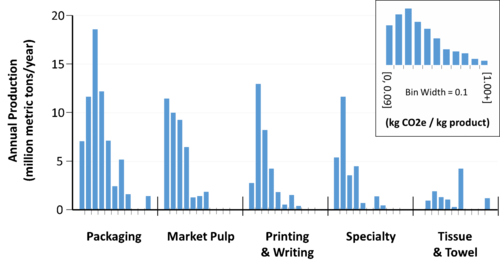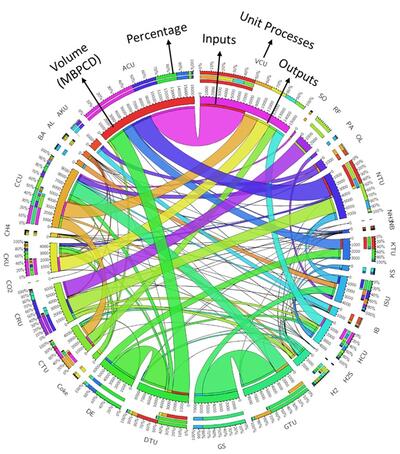Industrial decarbonization is critical to mitigate climate change. Our group develops data-driven and knowledge-based models to benchmark the GHG emissions and climate impacts of existing industries as well as quantify the carbon reduction potential of different technologies. Our goal is to provide insightful information to support climate policy and industry-wide management of GHG emissions.
Data-Driven Approach to Benchmark Carbon Footprints of Different Pulp and Paper Products
 Life Cycle Assessment (LCA) has been used to evaluate the life-cycle Greenhouse Gas (GHG) emissions of pulp and paper production, and most previous studies rely on process-based models for specific product types (e.g., printing paper), industry-average data, or information from a few mills. In this work, a data-driven approach is used to quantify GHG emissions intensities of different paper products manufactured by the U.S. mills. Facility-level emission data collected from publicly available government databases and mill-level production data collected from the private sector were integrated to track the GHG emissions for different product lines and paper products in mills. The results highlight the ranges of GHG emissions intensities by different product groups and categories and can be used as a transparent data source for LCA practitioners, policymakers, and the pulp and paper industry to perform further analysis on carbon accounting and strategic planning for GHG mitigation.
Life Cycle Assessment (LCA) has been used to evaluate the life-cycle Greenhouse Gas (GHG) emissions of pulp and paper production, and most previous studies rely on process-based models for specific product types (e.g., printing paper), industry-average data, or information from a few mills. In this work, a data-driven approach is used to quantify GHG emissions intensities of different paper products manufactured by the U.S. mills. Facility-level emission data collected from publicly available government databases and mill-level production data collected from the private sector were integrated to track the GHG emissions for different product lines and paper products in mills. The results highlight the ranges of GHG emissions intensities by different product groups and categories and can be used as a transparent data source for LCA practitioners, policymakers, and the pulp and paper industry to perform further analysis on carbon accounting and strategic planning for GHG mitigation.
Nabinger, A., Tomberlin, K., Venditti, R., and Y. Yao* (2019). Using a Data-Driven Approach to Unveil Greenhouse Gas Emission Intensities of Different Pulp and Paper Products, Procedia CIRP, 80, 689-692.
Carbon Reduction Potential and Cost of Carbon Capture Technology
 Carbon capture (CC) technology is receiving increasing attention as a critical technology for climate change mitigation. Most previous studies focus on the application of CC technology in the power generation sector, while fewer studies have analyzed applications in the refining industry, which is one of the largest greenhouse gas (GHG) emissions sources in the U.S. industrial sector. Unlike the power generation sector, the refining industry has highly distributed CO2 emission sources. In this paper, bottom-up modeling and techno-economic analysis approaches are integrated to quantify the national CO2 emission reduction potential and costs of three types of CC technologies applied to U.S. refineries: (1) pre-combustion, (2) post-combustion, and (3) oxyfuel-combustion. The results shown in this study provide an intuitive and quantitative understanding of the potential of CC technology to reduce CO2 emissions from the U.S. refining industry. Such information is helpful to policymakers, oil companies, and energy/environmental analysts for strategic planning and systems design to manage future CO2 emissions of refineries.
Carbon capture (CC) technology is receiving increasing attention as a critical technology for climate change mitigation. Most previous studies focus on the application of CC technology in the power generation sector, while fewer studies have analyzed applications in the refining industry, which is one of the largest greenhouse gas (GHG) emissions sources in the U.S. industrial sector. Unlike the power generation sector, the refining industry has highly distributed CO2 emission sources. In this paper, bottom-up modeling and techno-economic analysis approaches are integrated to quantify the national CO2 emission reduction potential and costs of three types of CC technologies applied to U.S. refineries: (1) pre-combustion, (2) post-combustion, and (3) oxyfuel-combustion. The results shown in this study provide an intuitive and quantitative understanding of the potential of CC technology to reduce CO2 emissions from the U.S. refining industry. Such information is helpful to policymakers, oil companies, and energy/environmental analysts for strategic planning and systems design to manage future CO2 emissions of refineries.
Yao, Y.*, Marano, J., Morrow, W. R. and E. Masanet (2018). Quantifying Carbon Capture Potential and Cost of Carbon Capture Technology Application in the U.S. Refining Industry. International Journal of Greenhouse Gas Control, 74, 87-98.